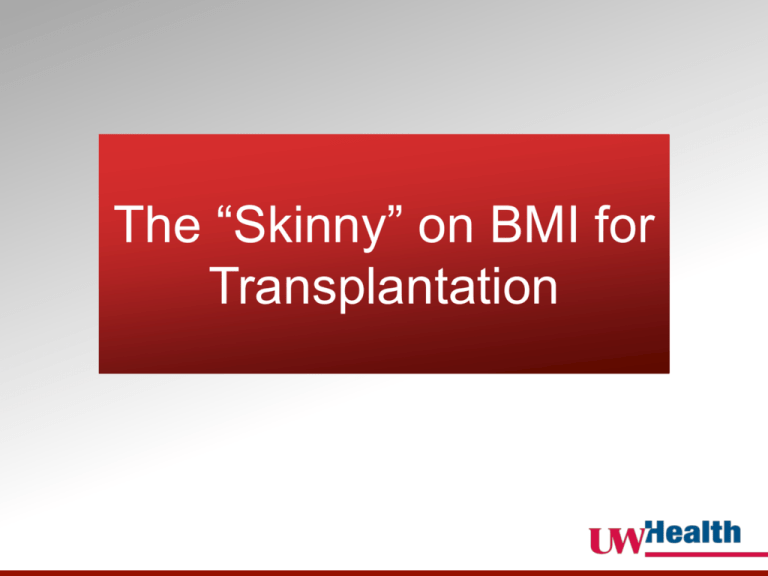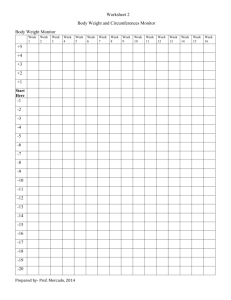Obesity - Transplant Pro
advertisement

The “Skinny” on BMI for Transplantation Outline • • • • • Body mass index (BMI) Measure of body weight Alternative ways to assess body fat Weight after transplant Setting criteria for your center (No Disclosures) What do these women have in common? The same Body Mass Index (BMI) Evolution of the term “Body Mass Index” 1972 Ancel Keys, “Indices of Relative Weight and Obesity.” Landmark study on body-fat percentage: − 7400 men in five countries − Compared formulas to directly measured values Confirmed the best predictor: − Adolphe Quetelet’s formula of the “average man” from 1835 (weight divided by height squared) Keys renamed it Body Mass Index Shah, B. (2006). Comparison of Ideal Body Weight Equations and Published Height-Weight Tables With Body Mass Index Tables for Healthy Adults in the United States. Nutrition in Clinical Practice, 21, 312-319. Calculation for BMI http://www.mdecg.com/what-is-bmi-and-why-its-important/ Body Mass Index BMI Classification BMI range – kg/m2 Risk co-morbidities <18.5 Low but other risks 18.5 – 24.9 Average Overweight 25 – 29.9 Mildly increased Obese Class I 30 – 34.9 Moderate Obese Class II 35 – 39.9 Severe Obese Class III > 40 Very Severe Category Underweight Normal Bray, G. (1998). What is Ideal Body Weight? Journal Nutrition Biochemistry, 9, 489-492. BMI Chart Comparison of Metropolitan Tables with Body Mass Index Height in inch/cm Metropolitan Metropolitan BMI 20 BMI 22 table (1959) table (1983) kg/m2 kg/m2 Men Women Men Women 57/144.8 45.36 50.80 58/147.3 46.72 51.71 59/149.9 48.08 52.84 44.9 49.4 60/152.4 49.44 53.98 46.5 51.1 61/154.9 52.84 50.80 59.42 55.34 Height in Metropolitan table Metropolitan table 48.0 BMI 52.8 20 62/157.5 54.43 52.39 60.33 56.70 49.6 54.5 inch/cm (1959) (1983) kg/m2 63/160.0 55.79 53.98 61.24 58.06 51.2 56.3 57.15 Men 56.02 62.37 59.42 52.9 58.1 Men 64/162.6 Women Women 65/165.1 58.74 57.83 63.50 60.78 54.5 59.9 59.65 64.8662.14 62.14 56.256.2 61.8 66/167.6 60.56 66/167.6 59.6560.56 64.86 67/170.2 62.60 61.46 66.23 63.50 57.9 63.7 68/172.7 64.41 63.28 67.59 64.86 59.7 65.6 69/175.3 66.23 65.09 68.95 66.23 61.4 67.5 70/177.8 68.27 66.91 70.31 67.59 63.2 69.5 71/180.3 70.31 71.90 68.95 65.0 71.5 72/182.9 73.48 73.48 66.9 73.5 73/185.4 74.39 75.30 68.8 75.6 74/188.0 76.66 76.88 70.7 77.7 75/190.5 78.93 78.93 72.6 79.8 BMI 25 BMI 30 kg/m2 kg/m2 56.1 67.4 58.1 69.7 60.0 72.0 BMI 22 62.0 2 kg/m74.4 64.0 76.8 66.1 79.3 68.1 81.8 70.3 61.884.3 72.4 86.9 74.6 89.5 76.8 92.1 79.0 94.8 81.3 97.6 83.6 100.3 86.0 103.1 88.3 106.0 90.7 108.9 Shah, B. (2006). Comparison of Ideal Body Weight Equations and Published Height-Weight Tables With Body Mass Index Tables for Healthy Adults in the United States. Nutrition in Clinical Practice, 21, 312-319. BMI 25 kg/m2 BMI 30 kg/m2 70.3 84.3 Ideal body weight (IBW) Men: IBW=106 pounds (lb) for first 5 ft. + 6 lb for each inch over 5 ft. Women: IBW=100 lb for first 5 ft. + 5 lb for each inch over 5 ft. For individuals under 5 ft.: Subtract 2 lb for every inch under 5 ft. Shah, B. (2006). Comparison of Ideal Body Weight Equations and Published Height-Weight Tables With Body Mass Index Tables for Healthy Adults in the United States. Nutrition in Clinical Practice, 21, 312-319 Weight-Height Indices Predictors Grady et al. study (1999): • Body weight measured by body mass index (BMI) and percentage ideal body weight (PIBW) • Looked at patient gender, age, and etiology of heart disease to see how correlated with BIM and PIBW • Conclusion: • Greatest risk for infection was found in patients who were >140% of IBW. • Cachexia or obesity preoperatively showed decreased survival in all patients after heart transplantation. • Percent ideal body weight appears to be the better predictor of future morbidity and mortality following heart transplantation. • Body Weight was not associated with acute rejection after transplant. Grady, K. (1999). Are Preoperative Obesity and Cachexia Risk Factors for Post Heart Transplant Morbidity and Mortality: A Multi-institutional Study of Preoperative Weight-Height Indices. The Journal of Heart and Lung Transplantation, 18, 750-763. 140% IBW vs BMI of 30 Difference between 140% IBW and BMI of 30 Female Height Male BMI 30(#) 140% IBW(#) BMI at 140% 140% IBW(#) BMI at 140% 4'10" 145 126 26.3 - - 5'0" 155 140 27.3 148 28.9 5'2" 165 154 28.1 165 30.2 5'4" 175 168 28.8 182 31.2 5'6" 185 182 29.3 198 32 5'8" 195 196 29.7 215 32.7 5'10" 210 210 28.7 232 33.3 6'0" 220 224 29.8 249 33.7 6'2" 230 238 30.5 266 35 140% IBW vs BMI of 30 Height BMI 30(#) 5'6" 185 140% IBW(#) BMI at 140% 140% IBW(#) BMI at 140% 182 29.3 198 32 Pros and Cons of using BMI Pros - Simple, inexpensive, and noninvasive - Correlates with future health risks - Widespread and longstanding Cons - Measures excess weight rather than excess body fat - Does not distinguish between excess fat, muscle, or bone mass - Does not provide indication of the distribution of fat - Does not consider age, gender, and race www.cdc.gov/obesity/downloads/BMIforPactitioners.pdf. Should BMI be the only risk criteria? National Heart, Lung, and Blood Institute recommends considering: 1) The individual's waist circumference (because abdominal fat is a predictor of risk for obesity-related diseases). 2) Other risk factors the individual has for diseases and conditions associated with obesity Abdominal fat Risk factor for numerous diseases: Cardiovascular disease Hypertension Stroke Non-insulin diabetes Molarius, A. (1998). Selection of Anthropometric indicators for classification of abdominal fatness-a critical review, International Journal of Obesity, 22, 719-727. Who is greater risk for other co-morbidities? Waist circumference National Institute of Health reported high waist circumference is associated with an increased risk for type 2 diabetes, dyslipidemia, hypertension, and CVD in patients with a BMI between 25 and 34.9 kg/m2 Retelny, V. (2008). Nutrition Protocols for the Prevention of Cardiovascular Disease. Nutrition in Clinical Practice, 23, 468-475. Changes in Waist Circumference Monitoring changes in waist circumference over time may be an estimate of increased abdominal fat even in the absence of a change in BMI. In obese patients with metabolic complications, changes in waist circumference are useful predictors of changes in CVD risk factors. Waist Circumference Measurement Errors Correct Waist Circumference Measuring Locate upper hip bone and the top of the right iliac crest. Place measuring tape around the abdomen at the level of the iliac crest. Measurement is made at the end of the normal expiration. Tape Position BMI and Waist Circumference Waist-to-hip ratio 1980 Gothenburg and a group from Wisconsin used waist-to-hip ratio to measure fat distribution. Waist circumference measures visceral fat and abdominal fat. The hip measurement may reflect muscle mass, fat mass, and skeletal frame. Molarius, A. (1998). Selection of Anthropometric indicators for classification of abdominal fatness - a critical review. International Journal of Obesity, 22, 719-727. Waist-to-Hip Ratio Standards Risk Men Women Ideal 0.8 0.7 Low Risk <0.90 <0.75 Moderate Risk 0.90 – 1.0 0.75 – 0.85 High Risk >1.0 >0.85 Bray, G. (1998). What is Ideal Body Weight? Journal of Nutrition Biochemistry, 9, 489-492. Skin calipers Skin calipers Bioelectric Impedance Analysis Contraindications The electrical signal is not felt safe for persons with cardiac pacemakers, and/or other medical devices implanted in the body. Underwater weighing DXA Scan (Dual X-Ray Absorptiometry) DXA Scans Body Fat Percentage Categories Classification Women (% fat) Men (% fat) Athletes 14-20% 6-13% Normal 14-20% 6-13% Borderline 31-33% 21-25% >33% >25% Obese Bray, G. (1998). What is Ideal Body Weight? Journal of Nutrition Biochemistry, 9, 489-492. Long term outcomes Cardiovascular events are the leading cause of mortality after solid organ transplant. Beckman, S. (2015). Weight gain, overweight and obesity in solid organ transplantation – a study protocol for systematic literature review. Systematic Reviews, 4, 2. Prevention of Cardiovascular Disease ♥ Eating patterns and physical activity have roles in managing weight and CVD risk. ♥ Weight maintenance and obesity prevention is necessary. ♥ Develop and implement a weight loss/maintenance program for all individuals above normal weight. Jensen, M. (2008). Obesity, behavioral lifestyle factors, and risk of acute coronary events. Circulation, 117, 3062-3069. What programs may help? Collaborate with Clinical Nutritionist Nutrition counseling pre and post transplantation Telephone consulting Internet technology for behavioral weight loss program Clinical Nutritionist • Trained/experienced in Nutrition for transplant • Nutrition Assessment • Nutrition Interventions • Nutrition Recommendations Telephone Consulting • Increase patient’s knowledge and understanding • Enhance success • Social support-empathy • Social reinforcement-praise for adherence • Awareness of discrepancies between personal goals and actual performance Sacco, W. P. (2009). Effect of a brief, regular telephone intervention by paraprofessionals for type 2 diabetes. Journal of Behavioral Medicine, 32, 349-359. Internet technology • Structured behavioral treatment program • Weekly contact • Individualized feedback Tate, D. F. (2001). Using Internet technology to deliver a behavioral weight loss program. Journal of the American Medical Association, 285, 1172- 1177. Staff and Programs • Nutritionist on each transplant team • Hospital programs • Community programs Trends in Transplantation Obesity is more prevalent and increasing Decrease in organ donation (need best candidates) Increase in evaluating and accepting obese candidates Obesity is a risk factor but what level of obesity causes adverse outcomes? Conclusion Monitor level of obesity in each organ transplantation group, outcomes, treatment regimen, and donor pool. Set defined weight criteria for each organ. Use another criteria along with BMI. Determine which weight loss programs are effective. Hasse, J. (2007). Pretransplant Obesity: A Weighty Issue Affecting Transplant Candidacy and Outcomes. Nutrition in Clinical Practice, 22, 494-504. References • Beckman, S. (2015). Weight gain, overweight and obesity in solid organ transplantation –a study protocol for systematic literature review. Systematic Reviews, 4, 2. • Bray, G. (1998). What is Ideal Body Weight? Journal of Nutrition Biochemistry, 9, 489-492. • Grady, K. (1999). Are Preoperative Obesity and Cachexia Risk Factors for Post Heart Transplant Morbidity and Mortality: A Multi-Institutional Study of Preoperative Weight-Height Indices. The Journal of Heart and Lung Transplantation, 18, 750-763. • Hasse, J. (2007). Pretransplant Obesity: A Weighty Issue Affecting Transplant Candidacy and Outcomes. Nutrition in Clinical Practice, 22, 494-504. • Jensen, M. (2008). Obesity, behavioral lifestyle factors, and risk of acute coronary events. Circulation., 117, 30623069. • Milaniak, I. (2014). Post-Transplantation Body Mass Index in Heart Transplant Recipients: Determinants and Consequences. Transplantation Proceedings, 46, 2844-2847. http://dx.doi.org/10.1016/j.transproceed.2014.09.025 • Molarius, A. (1998). Selection of Anthropometric indicators for classification of abdominal fatness-a critical review. International Journal of Obesity, 22, 719-727. • Retelny, V. (2008). Nutrition Protocols for the Prevention of Cardiovascular Disease. Nutrition in Clinical Practice, 23, 468-475. • Sacco, W. P. (2009). Effect of a brief, regular telephone intervention by paraprofessionals for type 2 diabetes. Journal of Behavioral Medicine, 32, 349-359. • Shah, B. (2006). Comparison of Ideal Body Weight Equations and Published Height-Weight Tables With Body Mass Index Tables for Healthy Adults in the United States. Nutrition in Clinical Practice, 21, 312-319. • Tate, D. F. (2001). Using Internet technology to deliver a behavioral weight loss program. Journal of the American Medical Association, 285, 1172-1177. • www.cdc.gov/obesity/downloads/BMIforPactitioners.pdf. (n.d.).




